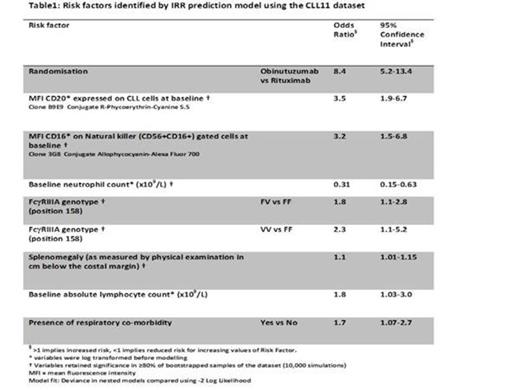Abstract
Background: The administration of anti-CD20 monoclonal antibodies (mAb) in patients with B-cell lympho-proliferative disorders is frequently accompanied by a constellation of signs and symptoms that have been labelled as infusion-related reactions (IRR). The pathophysiology of IRR remains poorly understood as do predictors of risk, which may relate to the mechanism of action of the anti-CD20, disease-related factors such as tumour burden or host factors such as polymorphisms of Fc gamma receptor 3A (FcγRIIIA).
In the CLL11 trial (NCT01010061), patients with previously untreated chronic lymphocytic leukaemia and comorbidities were randomised to receive either rituximab (type I anti-CD20 mAb) or obinutuzumab (type II and glycoengineered anti-CD20 mAb) in combination with chlorambucil for six cycles. Obinutuzumab led to faster depletion of B cells and achieved an improvement in outcome parameters such as response and progression-free survival compared with the rituximab arm, but was also associated with a higher rate and increased severity of IRR. To better understand the profile of risk for IRR in patients with CLL, we performed an exploratory analysis on data obtained from patients treated with either one of the two antibodies given in combination with chlorambucil.
Methods: Patients from the prospective, randomized Phase III CLL11 study who received a first infusion of obinutuzumab (N=331) or rituximab (N=326) were included. Baseline pre-treatment risk factors thought to play a possible role in the development of IRR were identified a priori and included patient demographics, concurrent conditions and premedications, parameters of disease burden, prognostic factors, laboratory variables and FcγR genotype. Baseline values for mean fluorescence intensity (MFI) of CD20, gated on the circulating CLL clone, and MFI of CD16, gated on the natural killer (NK) cell population (CD56+16+) in peripheral blood were also available for N=510 patients. The primary outcome, development of an IRR with the first infusion, was defined as the occurrence of related signs and symptoms during or within 24 hours of administration of antibody. Due to the short-term nature of the initial IRR a multivariate logistical regression analysis was performed rather than a time to event analysis. Internal validation of this model, derived from a single dataset, was conducted using the established resampling technique of bootstrapping. This assessed the proportion of times each variable retained significance at α=0.10 when the model was fitted to bootstrapped samples of the dataset.
Results: Patients that appeared to be at greater risk of developing any grade of IRR with the first infusion of rituximab or obinutuzumab were those treated with obinutuzumab, those with higher surface expression CD20 on CLL cells (MFI CD20) and greater FcγRIIIA (MFI CD16) on NK cells in peripheral blood, those with higher affinity FcγRIIIA genotype (VV), more pronounced neutropenia and splenomegaly at baseline (Table 1). Higher baseline absolute lymphocyte count and the presence of respiratory comorbidity also appeared to increase risk. All variables significant for inclusion in the model are shown in Table 1. Looking at those patients treated with obinutuzumab only, the most important determinant of risk was MFI CD20 (OR 3.6 95% CI 1.6-7.9). The impact of glucocorticoid premedication in reducing risk in obinutuzumab treated patients was not sufficient to reach significance, however, patients were not randomised to this intervention.
Conclusion: This work identifies novel disease- and patient-specific biological variables that appear to play a role in the development of IRR in patients with CLL treated with anti-CD20 mAb, although the treatment received (obinutuzumab >rituximab) confers greatest risk. In addition to parameters of tumour burden, target antigen expression and gene polymorphisms of FcγR also appear to contribute to the risk of developing an IRR. Our results support the hypothesis that higher rates of IRR seen with the administration of obinutuzumab may result from stronger activation upon binding to CD20 on leukemic cells and subsequent enhanced cross-linking between CD20 expressing leukemic cells and FcγRIIIA bearing effector cells. Further studies involving obinutuzumab in this patient population will be needed to externally validate the results of this exploratory analysis.
Freeman:Roche Pharmaceuticals: clinical research fellowship supported by Roche Pharmaceuticals (secondment from Bart's) Other. Dixon:Roche Pharmaceuticals: Employment. Houghton:Roche Pharmaceuticals: Employment. Humphrey:Roche: Employment. Fingerle-Rowson:Roche Pharmaceuticals: Employment. Kreuzer:Roche Pharmaceuticals: Research Funding. Engelke:Roche: Travel grants Other. Hallek:Roche Pharmaceuticals: Consultancy, Research Funding, Speakers Bureau. Goede:Bristol Myers Squibb: Honoraria; Mundipharma: Honoraria, Membership on an entity's Board of Directors or advisory committees, Research Funding; Roche: Honoraria, Membership on an entity's Board of Directors or advisory committees, Research Funding, Travel grants Other.
Author notes
Asterisk with author names denotes non-ASH members.


This feature is available to Subscribers Only
Sign In or Create an Account Close Modal